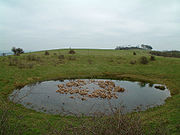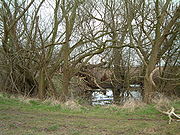
Dew pond
Encyclopedia

Pond
A pond is a body of standing water, either natural or man-made, that is usually smaller than a lake. A wide variety of man-made bodies of water are classified as ponds, including water gardens, water features and koi ponds; all designed for aesthetic ornamentation as landscape or architectural...
usually sited on the top of a hill, intended for watering livestock. Dew ponds are used in areas where a natural supply of surface water may not be readily available. The name dew pond (sometimes cloud pond or mist pond) is first found in the Journal of the Royal Agricultural Society
Royal Agricultural Society
The Royal Agricultural Society of England was established in the United Kingdom in 1838 with the motto "Practice with Science". The RASE aim is to promote the scientific development of agriculture. The society received its Royal Charter from Queen Victoria in 1840.From its early days the society...
in 1865. Despite the name, their primary source of water is believed to be rainfall rather than dew or mist.
Construction
They are usually shallow, saucer-shaped and lined with puddledPuddling (engineering)
Puddle is a watertight material based on clay used in building and maintaining canals or reservoirs. Puddling is the process of lining the channel with puddle....
clay
Clay
Clay is a general term including many combinations of one or more clay minerals with traces of metal oxides and organic matter. Geologic clay deposits are mostly composed of phyllosilicate minerals containing variable amounts of water trapped in the mineral structure.- Formation :Clay minerals...
, chalk
Chalk
Chalk is a soft, white, porous sedimentary rock, a form of limestone composed of the mineral calcite. Calcite is calcium carbonate or CaCO3. It forms under reasonably deep marine conditions from the gradual accumulation of minute calcite plates shed from micro-organisms called coccolithophores....
or marl
Marl
Marl or marlstone is a calcium carbonate or lime-rich mud or mudstone which contains variable amounts of clays and aragonite. Marl was originally an old term loosely applied to a variety of materials, most of which occur as loose, earthy deposits consisting chiefly of an intimate mixture of clay...
on an insulating straw layer over a bottom layer of chalk or lime. To deter earthworms from their natural tendency of burrowing upwards, which in a short while would make the clay lining porous, a layer of soot would be incorporated or lime mixed with the clay. The clay is usually covered with straw to prevent cracking by the sun and a final layer of chalk rubble or broken stone to protect the lining from the hoofs of sheep or cattle.
A method of constructing the base layer using chalk puddle was described in The Field 14 December 1907.
A Sussex farmer born in 1850 tells how he and his forefathers made dew ponds:
If the pond's temperature is kept low, evaporation (a major water loss) may be significantly reduced, thus maintaining the collected rainwater. As the water level in the basin falls a well of cool, moist air tends to form over the surface, restricting evaporation.
History

Rudyard Kipling
Joseph Rudyard Kipling was an English poet, short-story writer, and novelist chiefly remembered for his celebration of British imperialism, tales and poems of British soldiers in India, and his tales for children. Kipling received the 1907 Nobel Prize for Literature...
tells us in Puck of Pook's Hill
Puck of Pook's Hill
Puck of Pook's Hill is a historical fantasy book by Rudyard Kipling, published in 1906, containing a series of short stories set in different periods of English history. The stories are all narrated to two children living near Burwash, in the area of Kipling's own house Bateman's, by people...
. The two Chanctonbury Hill
Chanctonbury Ring
Chanctonbury Ring is a hill fort based ring of trees atop Chanctonbury Hill on the South Downs, on the border of the civil parishes of Washington and Wiston in the English county of West Sussex. A ridgeway, now part of the South Downs Way, runs along the hill...
dew ponds were dated, from flint tools excavated nearby and similarity to other dated earthworks, to the neolithic period
Neolithic
The Neolithic Age, Era, or Period, or New Stone Age, was a period in the development of human technology, beginning about 9500 BC in some parts of the Middle East, and later in other parts of the world. It is traditionally considered as the last part of the Stone Age...
. Landscape archaeology
Landscape archaeology
Landscape archaeology is the study of the ways in which people in the past constructed and used the environment around them. Landscape archaeology is inherently multidisciplinary in its approach to the study of culture, and is used by both pre-historical, classic, and historic archaeologists...
too seemed to demonstrate that they were used by the inhabitants of the nearby hill fort
Hill fort
A hill fort is a type of earthworks used as a fortified refuge or defended settlement, located to exploit a rise in elevation for defensive advantage. They are typically European and of the Bronze and Iron Ages. Some were used in the post-Roman period...
(probably from an earlier date than that of the surviving late bronze age
Bronze Age
The Bronze Age is a period characterized by the use of copper and its alloy bronze as the chief hard materials in the manufacture of some implements and weapons. Chronologically, it stands between the Stone Age and Iron Age...
structure) for watering cattle. A more prosaic assessment from Maud Cunnington
Maud Cunnington
Maud Edith Cunnington , was a Welsh-born archaeologist, most famous for her pioneering work on the prehistoric sites of Salisbury Plain....
, an archaeologist from Wiltshire, while not ruling out a prehistoric origin, describes such positive interpretations of the available evidence as no more than “flights of fancy”. A strong claim to antiquity may, however, be made for at least one Wiltshire dew pond: A land deed
Deed
A deed is any legal instrument in writing which passes, or affirms or confirms something which passes, an interest, right, or property and that is signed, attested, delivered, and in some jurisdictions sealed...
dated 825 CE
Common Era
Common Era ,abbreviated as CE, is an alternative designation for the calendar era originally introduced by Dionysius Exiguus in the 6th century, traditionally identified with Anno Domini .Dates before the year 1 CE are indicated by the usage of BCE, short for Before the Common Era Common Era...
mentions Oxenmere (51.375960°N 1.848221 °W) at Milk Hill
Milk Hill
Milk Hill, located near Alton Priors east of Devizes, is the highest point in the county of Wiltshire, southwest England, at some 295 m / 968 ft above sea level...
, Wiltshire, showing that dew ponds were in use during the Saxon
Anglo-Saxons
Anglo-Saxon is a term used by historians to designate the Germanic tribes who invaded and settled the south and east of Great Britain beginning in the early 5th century AD, and the period from their creation of the English nation to the Norman conquest. The Anglo-Saxon Era denotes the period of...
period. The parliamentary enclosures of the mid eighteenth to mid nineteenth centuries caused many new upland ponds to be made, as access to traditional sources of drinking water for livestock was cut off. The naturalist Gilbert White
Gilbert White
Gilbert White FRS was a pioneering English naturalist and ornithologist.-Life:White was born in his grandfather's vicarage at Selborne in Hampshire. He was educated at the Holy Ghost School and by a private tutor in Basingstoke before going to Oriel College, Oxford...
noted that during extended periods of summer drought the artificial ponds on the downs
Downland
A downland is an area of open chalk hills. This term is especially used to describe the chalk countryside in southern England. Areas of downland are often referred to as Downs....
above his native Selborne
Selborne
Selborne is a village in the East Hampshire district of Hampshire, England. It is south of Alton. It will be just within the extreme northern boundary of the proposed South Downs National Park, which is due to take effect in mid-2010....
, Hampshire, retained their water, despite supplying flocks of sheep, while larger ponds in the valley below had dried up. Later observations demonstrated that during a night of favourable dew formation a typical increase in water level of some two or three inches was possible.
There is equal controversy on the means of replenishment of dew ponds. Experiments conducted in 1885 to determine the origin of the water found that dew forms not from dampness in the air but from moisture in the ground directly beneath the site of the condensation: dew, therefore, was ruled out as a source of replenishment. Other scientists have pointed out that the 1885 experiments failed to take into account the insulating effect of the straw and the cooling effect of the damp clay: the combined effect would be to keep the pond at a lower temperature than the surrounding earth and thus able to condense a disproportionate share of moisture.
In turn these conclusions were disproved in the 1930s, when it was pointed out that the heat-retaining quality of water (its thermal capacity) was many times greater than that of earth and therefore the air above a pond in summer would be the last place to attract condensation. The deciding factor, it was concluded, is the extent of the saucer-shaped basin extending beyond the pond itself: the large basin would deliver more rainfall than a pond created without such a surrounding feature.
Dew ponds are still common on the downlands of southern England
England
England is a country that is part of the United Kingdom. It shares land borders with Scotland to the north and Wales to the west; the Irish Sea is to the north west, the Celtic Sea to the south west, with the North Sea to the east and the English Channel to the south separating it from continental...
, the North Derbyshire
Derbyshire
Derbyshire is a county in the East Midlands of England. A substantial portion of the Peak District National Park lies within Derbyshire. The northern part of Derbyshire overlaps with the Pennines, a famous chain of hills and mountains. The county contains within its boundary of approx...
and Staffordshire moorlands
Staffordshire Moorlands
Staffordshire Moorlands is a local government district in Staffordshire, England. Its council, Staffordshire Moorlands District Council, is based in Leek and is located between the city of Stoke-on-Trent and the Peak District National Park. The 2001 census recorded the population as...
and in Nottinghamshire
Nottinghamshire
Nottinghamshire is a county in the East Midlands of England, bordering South Yorkshire to the north-west, Lincolnshire to the east, Leicestershire to the south, and Derbyshire to the west...
.
Articles
- Dew Ponds to the rescue
- Topline information about Wiltshire dew ponds
- Article about dew ponds in Ascension Island
How to build dew ponds
- Catch and Collect the Dew in a Pond, Simple instructions on how to build a dew pond.

